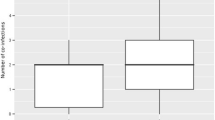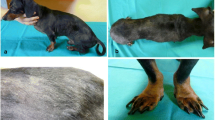Summary
Currently no information is available regarding canine arthropod-borne parasites in Albania and the Kosovo, especially the zoonotic protozoan Leishmania infantum. Presumably autochtonous cases of human leishmaniosis have been described for some areas (Kosovo: Ferizaj, Gjakovo, Pec, Malisevo; Albania: Tirana, Durres, Elbasan, Shkodra, Vlore). In order to investigate the infection status of dogs of different origin sera from 272 animals (151 from Albania – Tirana, Kamza and Durres; 121 from the Kosovo – Gjakovo, Ferizaj and Prishtina) were obtained. Corresponding blood samples were available from 36 Albanian stray dogs. Antibody titres were determined by Indirect Immunofluorescence Test against L. infantum and Babesia canis. Antigens of Dirofilaria immitis were determined using the DiroCheck®-Test. Blood samples were tested for L. infantum, B. canis, Hepatozoon canis, D. immitis and Dirofilaria repens by polymerase chain reaction (PCR). Specific antibodies against Babesia were found in 7.3% of the animals, against Leishmania in 3.3% and 7.0% were positive for D. immitis antigen. DNA of Babesia, Leishmania or D. repens was detected in 11.1%, respectively. H. canis was found in 52.8% of the blood samples. D. immitis DNA was not detected. Since the Babesia- and Leishmania-PCR-positive animals were all serologically negative it can be assumed that infections were acquired only recently. All Leishmania-positive animals were stray dogs. These animals contribute to the maintenance of Leishmania transmission in endemic areas, and a control of the canine stray population should be considered.
Zusammenfassung
Über die Verbreitung arthropodenübertragener Parasiten bei Hunden in Albanien und im Kosovo, insbesondere des Zoonoseerregers Leishmania infantum, gibt es keine aktuellen Informationen. Vermutlich autochthone Fälle von humaner Leishmaniose sind aus einigen Gegenden (Kosovo: Ferizaj, Gjakovo, Pec, Malisevo; Albanien: Tirana, Durres, Elbasan, Shkodra, Vlore) berichtet worden. Um den Infektionsstatus von Hunden verschiedener Herkunft und Haltung zu erheben, wurde Serum von 272 Tieren (151 aus Albanien – Tirana, Kamza, Durres; 121 aus dem Kosovo – Gjakovo, Ferizaj und Prishtina) gewonnen. Von 36 Streunern aus Albanien standen korrespondierende Blutproben zur Verfügung. Für alle Tiere wurde der klinische Status erhoben. Die Serumproben wurden mittels Indirektem Immunfluoreszenztest auf Antikörper gegen L. infantum und Babesia canis sowie mit dem DiroCheck®-Test auf Antigen von Dirofilaria immitis untersucht. Die Blutproben wurden mittels Polymerasekettenreaktion (PCR) auf das Vorhandensein von L. infantum, B. canis, Hepatozoon canis, D. immitis und D. repens überprüft. Serologisch waren 7,3% der Tiere positiv für Babesien-Antikörper, 3,3% für Leishmanien-Antikörper und 7,0% für Dirofilarien-Antigen. In der PCR erwiesen sich jeweils 11,1% der Tiere positiv für Babesien, Leishmanien oder D. repens. H. canis war in 52,8% der Blutproben zu finden. D. immitis war mittels PCR nicht nachweisbar. Da die Babesia- und Leishmania-PCR-positiven Tiere serologisch negativ waren, ist anzunehmen, dass es sich um gerade erworbene Infektionen handelte. Alle Leishmania-positiven Tiere waren Streuner. Diese Tiere sind für die Aufrechterhaltung der Leishmanienübertragung in den endemischen Gebieten mit verantwortlich, und eine Kontrolle der Streunerpopulation sollte in Betracht gezogen werden.
Similar content being viewed by others
Literatur
Shaw SE, Day MJ (2005) Arthropod-borne infectious diseases of the dog and cat. Manson, London
Gramiccia M, Gradoni L (2005) The current status of zoonotic leishmaniases and approaches to disease control. Int J Parasitol 35: 1169–1180
Dantas-Torres F (2007) The role of dogs as reservoirs of Leishmania parasites, with emphasis on Leishmania (Leishmania) infantum and Leishmania (Viannia) braziliensis. Vet Parasitol 149: 139–146
Baneth G, Koutinas AF, Solano-Gallego L, Bourdeau P, Ferrer L (2008) Canine leishmaniosis – new concepts and insights on an expanding zoonosis: part one. Trends Parasitol 24: 324–330
Genchi C, Rinaldi L, Cringoli G (2007) Dirofilaira immitis and D. repens in dog and cat and human infections. Mappe Parassitologiche, Rolando Editore, Neapel
Vélez ID, Montoya MN, Prieto G, Morchón R, Simón F (2001) Epidemiology of human dirofilariosis. In: Simón F, Gechni C (eds) Heartworm infection in humans and animals. Ediciones Universidad de Salamaca, Salamanca, pp 135–146
Deplazes P, Staebler S, Gottstein B (2006) Reisemedizin parasitärer Erkrankungen des Hundes. Schweiz Arch Tierheilk 148 (9): 447–461
Lindgren E, Naucke T, Menne B (2008) Climate variability and visceral leishmaniasis in Europe. TropIKA.net (www.tropica.net/svc/review/040202-Leishmaniasis_ClimateChange, 30.7.2008)
Rishniw M, Barr SC, Simpson KW, Frongillo MF, Franz M, Dominguez Alpizar JL (2006) Discrimination between six species of canine microfilariae by a single polymerase chain reaction. Vet Parasitol 135 (3–4): 303–314
Dürbaum M (1999) Canine Babesiose: Übersicht über den gegenwärtigen Kenntnisstand und Hinweise auf ein endemisches Vorkommen im Raum Düren. Diss Tierärztl Hochsch Hannover
Cacciò SM, Antunovic B, Moretti A, Mangili V, Marinculic A, Baric RR, Slemenda SB, Pieniazek NJ (2002) Molecular characterisation of Babesia canis canis and Babesia canis vogeli from naturally infected European dogs. Vet Parasitol 106: 285–292
Duh D, Tozon N, Petrovec M, Strasek K, Avsic-Zupanc T (2004) Canine babesiosis in Slovenia: molecular evidence of Babesia canis canis and Babesia canis vogeli. Vet Res 35: 363–368
Baneth G, Mathew JS, Shkap V, Macintire DK, Barta JR, Ewing SA (2003) Canine hepatozoonsis: two disease syndromes caused by separate Hepatozoon spp. Trends Parasitol 19: 27–31
Criado-Fornelio A, Buling A, Cunha-Filho NA, Ruas JL, Farias NA, Rey-Valeiron C, Pingret JL, Etievant M, Barba-Carretero JC (2007) Development and evaluation of a quantitative PCR assay for detection of Hepatozoon sp. Vet Parasitol 150: 352–356
Gradoni L (1999) Epizoology of canine leishmaniasis in southern Europe. In: Proc Int Canine Leishmaniasis Forum, Barcelona, pp 32–39
Bosnic S, Gradoni L, Khoury C, Maroli MA (2006) A review of leishmaniasis in Dalmatia (Croatia) and results from recent surveys on phlebotomine sandflies in three southern counties. Acta Trop 99 (1): 42–49
Živicnjak T, Martinkovic F, Marinculic A, Mrljak V, Kucer N, Matijatko V, Mihaljevic Z, Baric-Rafaj R (2005) A seroepidemiological survey of canine visceral leishmaniosis among apparently healthy dogs in Croatia. Vet Parasitol 131 (2): 35–43
Adhami J, Murati N (1977) Canine leishmaniasis and the natural reservoir of visceral leishmaniasis in Albania. Bulletini i Universitetit te Tiranes, Seria Shkencat Mjeksore 4: 69–74
Velo E, Bino S, Kuli-Lito G, Pano K, Gradoni L, Maroli M (2003) Recrudescence of visceral leishmaniasis in Albania: retrospective analysis of cases during 1997 to 2001 and results of an entomological survey carried out during 2001 in some districts. Transact Royal Soc Trop Med Hyg 97: 288–290
Lito G, Davachi F, Sulcebe G, Bregu H, Basha M (2002) Pediatric visceral leishmaniasis in Albania. Int J Inf Dis 6: 66–68
Adhami J, Bashari V, Murati N, Bebej S, Gjoka DH (1983) Epidemiology of leishmaniasis in the Gjirokastra District (South Albania). Bulletini i Universitetit te Tiranes, Seria Shkencat Mjeksore 2: 65–73
Simitch T, Živkovic V (1956) Die Phlebotomenfauna Jugoslawiens und ihre epidemiologische Rolle für das Papataccifieber, Kala-Azar und die Orientbeule. Arch Inst Pasteur d'Algerie 34: 380–387
Todhe P (1963) Infantile leishmaniasis in Shkodra district. Mjeksia Popullore 2: 13–18
Adhami J, Murati N (1986) The distribution characteristics of visceral leishmaniasis, 1960–1984. Higjena dhe Epidemiologjia 5: 12–21
Kero A, Xinxo A (1998) Epidemiological characteristics of leishmaniasis in Albania in the period 1984–1996. Giornale di Italiano di Medicina Tropicale 3: 55–57
Cani E, Myrseli T, Petrela R, Minarolli P, Pano K (2001) Viszerale Leishmaniose – eine Zoonose mit hohem möglichem Risiko in Albanien. Rev Vet (Tirana) 5: 81–92 (albanisch)
Dreshaj Sh, Tolaj I, Doda T, Shurdhani S, Hetemi K, Kryeziu E, Sadiku Sh, Mulliqi GJ (2004) Klinik und Labordiagnostik bei Kala-Azar-Patienten, die in der Infektionsklinik in Pristhina behandelt wurden. Praxis Media 46: 16–22 (albanisch)
Dantas-Torres F (2007) The role of dogs as reservoirs of Leishmania parasites, with emphasis on Leishmania (Leishmania) infantum and Leishmaina (Vannia) braziliensis. Vet Parasitol 149: 139–146
Author information
Authors and Affiliations
Corresponding author
Rights and permissions
About this article
Cite this article
Lazri, T., Duscher, G., Edelhofer, R. et al. Infektionen mit arthropodenübertragenen Parasiten bei Hunden im Kosovo und in Albanien unter besonderer Berücksichtigung der Leishmanieninfektionen. Wien Klin Wochenschr 120 (Suppl 4), 54–58 (2008). https://doi.org/10.1007/s00508-008-1076-4
Issue Date:
DOI: https://doi.org/10.1007/s00508-008-1076-4




